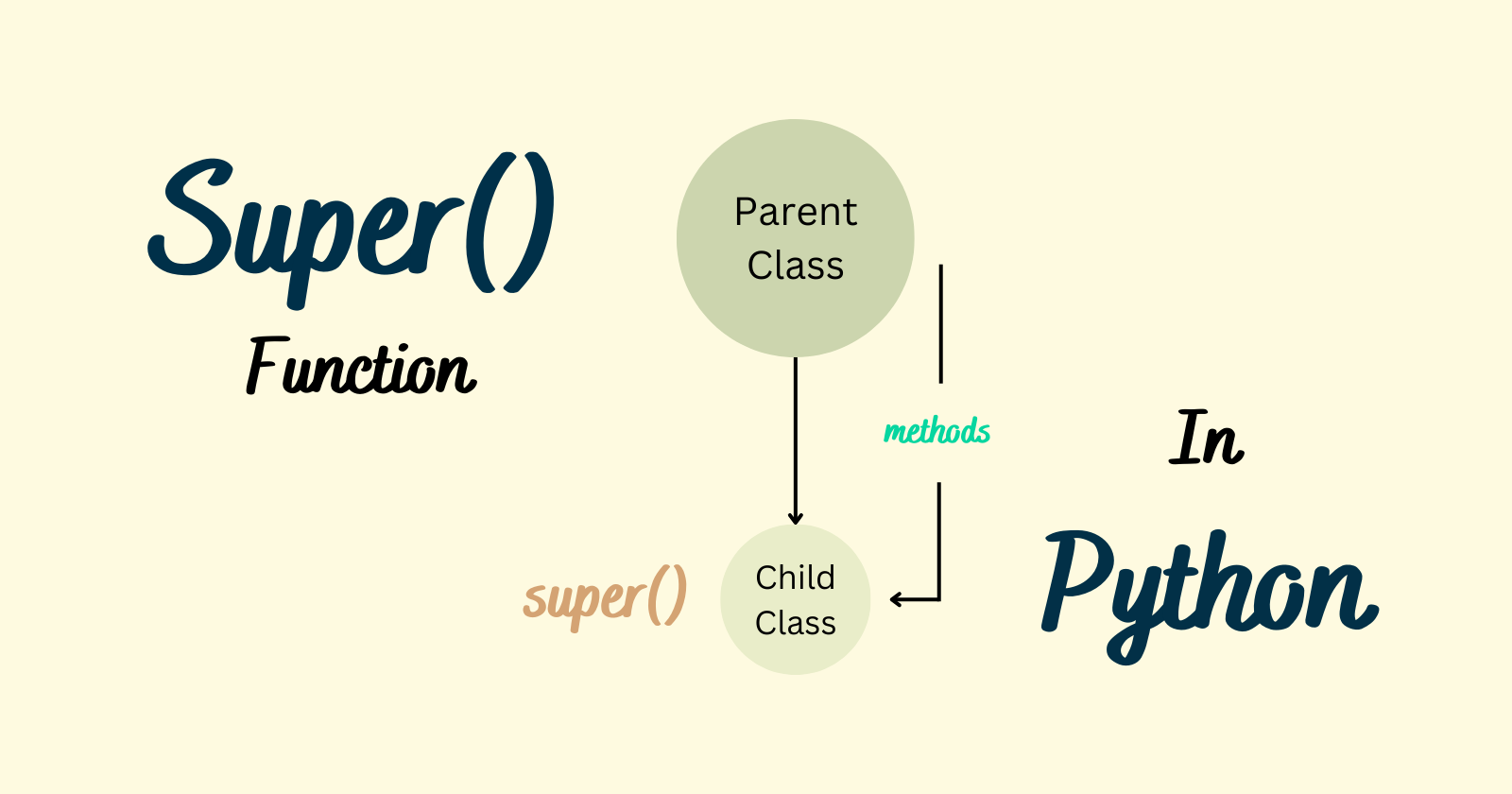You may have heard the term inheritance in object-oriented programming, and if you haven’t, don’t worry because we’ve got your back.
Inheritance is one of the four pillars of object-oriented programming, and it can be defined as a mechanism that allows a specific class to inherit the attributes and methods of the parent class without having to implement them again.
Python has an excellent function called super() that allows the parent class’s attributes and methods to be fully accessible within a subclass.
What does the super() function do and how does it help with class inheritance in Python?
Super in Python
To put it simply, the super() function extends the functionality of the superclass within the subclass or derived class. Assume we created a class and wanted to extend the functionality of a previously created class within that specific class; in that case, we’ll use the super() function.
Let’s look at an example to get a better understanding of the super() function in Python.
|
1 2 3 4 5 6 7 8 9 10 11 12 13 14 15 16 17 18 |
# Super method demonstration class BestFriend: def __init__(self): self.name1 = "Rishu" self.name2 = "Yashwant" self.name3 = "Abhishek" class Friends(BestFriend): def __init__(self): super().__init__() def friends(self): print(self.name1) print(self.name2) print(self.name3) obj = Friends() obj.friends() |
We made two classes, BestFriend and Friend, with the subclass or derived class Friend inheriting from the parent class BestFriend. However, in order to fully access the parent class within a derived class, we instantiated the parent class using the super() function.
|
1 2 3 |
Rishu Yashwant Abhishek |
Syntax
The syntax of the super() function can be written as the following
|
1 2 3 |
class X(Z): def method(self, args): super(X, self).method(args) |
Here:
X – is an optional parameter that represents the name of the subclass.
self – is the instance object of the derived class X.
method – is a normal function.
args – are the arguments of the function.
What does the super() function do?
We saw earlier how to use the super() function within a subclass to extend the functionality of the parent class. And it’s no surprise that the super() function is mostly used to extend the functionality of the parent class within the subclass.
super() function in single inheritance
Single inheritance is one in which the subclass or derived class inherits from a single parent class or superclass.
In the following example, there are two classes: Triangle and RightTriangle. Both classes have functions area that return the area of a triangle and a right-angle triangle.
Then we created instances of both classes, triangle and rtriangle, and passed them the necessary arguments. Then, using the respective instance variable, we called the function area of both classes.
|
1 2 3 4 5 6 7 8 9 10 11 12 13 14 15 16 17 18 19 20 21 |
class Triangle: def __init__(self, a, b): self.a = a self.b = b def area(self): return (self.a * self.b) / 2 class RightTriangle: def __init__(self, a, b): self.a = a self.b = b def area(self): return (self.a * self.b) / 2 triangle = Triangle(2, 4) print(f"Area of triangle: {triangle.area()}") rtriangle = RightTriangle(2, 3) print(f"Area of right-angle triangle: {rtriangle.area()}") |
We got the following output which was expected from the program.
|
1 2 |
Area of triangle: 4.0 Area of right-angle triangle: 3.0 |
However, by using inheritance and the super() function, we can reduce the amount of time we spend writing the same logic over and over. Let’s see how we can do it with the aforementioned code.
|
1 2 3 4 5 6 7 8 9 10 11 |
class Triangle: def __init__(self, a, b): self.a = a self.b = b def area(self): return (self.a * self.b) / 2 class RightTriangle(Triangle): def __init__(self, a, b): super().__init__(a, b) |
The class RightTriangle derives from the parent class Triangle, and we extended the functionality of the parent class within the subclass RightTriangle by using the super() function.
If we call the function area using the derived class RightTriangle, the code will run without error and we will get the correct output.
|
1 2 3 4 5 |
rtriangle = RightTriangle(2, 3) print(f"Area of right-angle triangle: {rtriangle.area()}") ---------- Area of right-angle triangle: 3.0 |
Because the derived class RightTriangle has access to the methods in the parent class Triangle, the code completed the task successfully.
What else super() function can do?
We saw the basic usage of the super() function in the preceding segment, and we’ll see many more examples in this segment to help us understand more concepts of the super() function.
As we saw earlier, the super() function can take two parameters, but it can also be called without any parameters, as shown in the above code.
|
1 2 3 4 5 6 7 8 9 10 11 |
class Triangle: def __init__(self, a, b): self.a = a self.b = b def area(self): return (self.a * self.b) / 2 class RightTriangle(Triangle): def __init__(self, a, b): super(RightTriangle, self).__init__(a, b) |
You can see that the derived class RightTriangle is the first parameter we passed, and the RightTriangle object self is the second. The code will continue to function flawlessly as before and won’t be at all impacted by this.
Calling super(RightTriangle, self) is equivalent to calling super() without parameters. In most cases, however, it is recommended that you use the parameter-free super() function.
|
1 2 3 4 5 |
rtriangle = RightTriangle(2, 3) print(f"Area of right-angle triangle: {rtriangle.area()}") ---------- Area of right-angle triangle: 3.0 |
Another subclass that inherits from the first subclass and extends the functionality of the parent class inside the second subclass can also use super(). Let’s use an example to better understand it.
The function area, which was originally inherited from the class Rectangle through the subclass Square, is extended by the subclass Circle in the example below to return the area of the circle.
|
1 2 3 4 5 6 7 8 9 10 11 12 13 14 15 16 17 18 19 |
class Rectangle: def __init__(self, a, b): self.a = a self.b = b def area(self): return self.a * self.b class Square(Rectangle): def __init__(self, a): super(Square, self).__init__(a, a) class Circle(Square): def c_area(self): circle_area = super().area() return 3.14 * circle_area obj = Circle(3) print(obj.c_area()) |
If we run the aforementioned code, we will obtain the circle’s area calculated for a radius of 3.
|
1 |
28.26 |
super() function in multiple inheritance
After seeing how the super() function is used in single inheritance, we will now use examples to show how it is used in multiple inheritance.
Multiple inheritance is a type of inheritance where a subclass inherits from various parent classes.
The class Cylinder in the example below inherits from the classes Circle and Rectangle. Like in the single inheritance example, we used the area function via the super() function.
|
1 2 3 4 5 6 7 8 9 10 11 12 13 14 15 16 17 18 19 20 21 22 23 24 25 26 27 |
class Rectangle: def __init__(self, a, b): self.a = a self.b = b def area(self): return self.a * self.b class Circle: def __init__(self, a): self.a = a def area(self): return 3.14 * (self.a * self.a) class Cylinder(Rectangle, Circle): def cy_area(self): area = 2 * 3.14 * super().area() area1 = 2 * (super().area()) cylinder_area = area + area1 return cylinder_area obj = Cylinder(2, 3) print(obj.cy_area()) |
The aim of the code is to print the area of the cylinder, and the function cy_area holds the logic to process it.
|
1 |
49.68 |
The code returns the above output, which is wrong, and this happens because the function area we called using the super() function is actually coming from the base class Rectangle.
If we look at the MRO (Method Resolution Order), that tells Python where to look for the inherited method.
|
1 2 3 4 5 |
mro = Cylinder.__mro__ print(mro) ---------- (<class '__main__.Cylinder'>, <class '__main__.Rectangle'>, <class '__main__.Circle'>, <class 'object'>) |
Here, we can clearly see that Python will look for the inherited methods from the class Rectangle, and if the specific method is found in it, it will be used; otherwise, it will move ahead.
However, we want the variable area to access the function area via the class Rectangle and variable area1 to access the function area via the class Circle.
You can change the order in which the base classes are inherited, though, if you ever need to use contradictory methods from classes within a subclass.
The solution to this problem is that we can modify the names of the function.
|
1 2 3 4 5 6 7 8 9 10 11 12 13 14 15 16 17 18 19 20 21 22 23 24 25 26 27 |
class Rectangle: def __init__(self, a, b): self.a = a self.b = b def r_area(self): return self.a * self.b class Circle: def __init__(self, a): self.a = a def c_area(self): return 3.14 * (self.a * self.a) class Cylinder(Rectangle, Circle): def cy_area(self): area = 2 * 3.14 * super().r_area() area1 = 2 * (super().c_area()) cylinder_area = area + area1 return cylinder_area obj = Cylinder(2, 3) print(obj.cy_area()) |
We changed the function’s name inside the class Rectangle and set it to r_area. We did the same inside the class Circle and set the function’s name to c_area. This gives the issue a short-term solution.
|
1 |
62.8 |
Note: When multiple inheritance is used, the order of the parent classes determines whether to use this class’ methods first or that class’ methods.
Conclusion
We used the super() function in this tutorial to give subclasses full access to the parent classes’ methods and attributes. We first learned about the super() function through an example, and then we looked at the syntax.
Then, using code examples, we delve deep into the super() function to understand more concepts. Then we saw the use of super() in single and multiple inheritance, as well as a glimpse of the RMO, which is used in Python to resolve method calls.
🏆Other articles you might be interested in if you liked this one
✅Introduction to the different types of class inheritance in Python.
✅Public, Protected and Private access modifiers in Python.
✅Match case statement for pattern matching in Python.
✅Upload and display images on the frontend using Flask in Python.
✅8 different ways to reverse a Python list.
✅Reverse vs Reversed function in Python.
That’s all for now
Keep Coding✌✌





